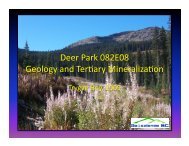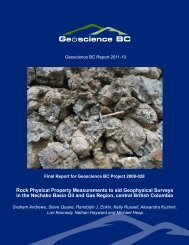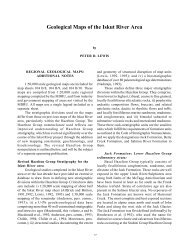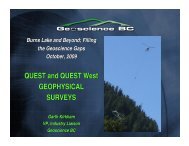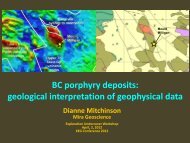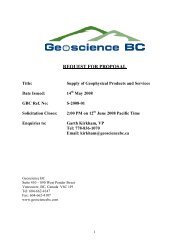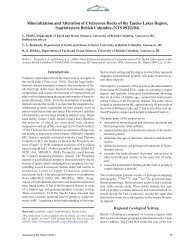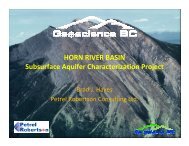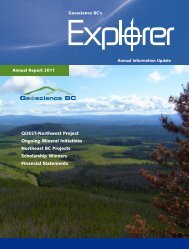Final Report - Geoscience BC
Final Report - Geoscience BC
Final Report - Geoscience BC
You also want an ePaper? Increase the reach of your titles
YUMPU automatically turns print PDFs into web optimized ePapers that Google loves.
1. The Importance of Physical Rock Properties to ExplorationAdvances of proven geophysical methods and techniques to interpret and visualize geophysicaldata require physical rock property data to relate the key geological aspects of ore deposits andtheir host rocks. Petrophysical analysis of specific ore systems is required to determine whatgeophysical techniques can best be used to target mineralization. The explorationist must startwith a concept of the ore deposit model which then provides clear guidance about possiblephysical property contrasts and can guide selection of the appropriate geophysical methods, theirappropriate use and how to interpret them. Various types of rock property data provideinformation on mineralogy, texture, grain size and porosity. Most importantly, differenttechniques exhibit contrasts that can then be imaged to reveal geometries between rock bodies.The process starts with a concept exploration model then data needs to be acquired that includesmeasurements of rock samples, outcrops and drill core. A preferred method is to measure a rangeof parameters from probes lowered into boreholes. Borehole measurements require planning fora budget as part of drilling programs, access to a representative number of boreholes, cost andtime, calibration of instruments and attention to the consistency of type of data received. If sucha plan is considered prohibitive, a company can measure selective borehole cores andrepresentative rock types to guide initial interpretations of geophysical surveys. Any programneeds communication between the geologist with respect to the geological model and thegeophysicist with respect to the geophysics. For all rock property data measured, a spreadsheetneeds to be set up to record the geophysical parameter, the location by GPS coordinates, the rocktype and the geological formation. It is also useful to record mineralogy, modal geochemistryalteration type as a confirmation of the rock type. Metadata is always important to enter into datafiles such as the method of geophysical measurement.The integration of all geological, geophysical and geochemical data into a 3D GIS model is thenext step and constitutes around 80% of the work. The whole earth models that are constructedshould provide structural geometry, lithological units, and alteration among other aspects.Geophysical data can be modeled synthetically as a forward model that krigs and smooths the1





